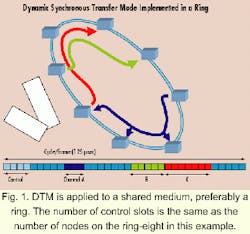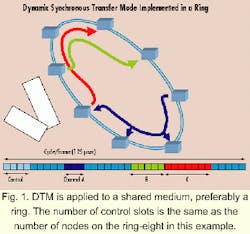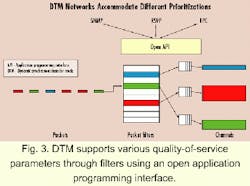DTM technology for carrier-class optical IP networks
The communications market is undergoing radical changes. The trend toward the convergence of data-communications and telecommunications services is forcing equipment vendors and service providers to rethink future network architectures and service offerings.
Three major trends are driving the development and deployment of next-generation networks:
- End-user demands: The end users, including the home market and enterprises, constantly require improved quality of network services, supreme availability and reliability, and lower prices. These requirements need to be addressed by the carriers and service providers to stay current and extend to new subscribers more services and features.
- Global deregulation: In the deregulated market, the carriers and service providers have to rethink differentiation and positioning strategies to maintain market share and profitability. In the telecommunications market, emerging carriers are backed by venture capital, and the incumbent providers are seeking new markets.
- Technology: The only means of staying ahead of other competitors is by implementing breakthrough technology. The most significant technological advances would have to be in fiber optics--how fiber optics are deployed, the use of wavelength-division multiplexing (WDM), Internet protocol (IP), etc.--which has evolved to become the predominant platform for network services. Also significant is wireless technology, which has extended broadband access in a very cost-effective manner.
It is obvious that we have only begun to see the "new services era"-increases in the number of users and advanced applications and services will indeed drive the need for a new generation of networks. Some of the more important requirements for this era of new services include:
- IP: The first important criterion is that the network be developed with an IP-centric view. IP will evolve to become the prevailing service layer, and the network has to be optimized to realize current and future IP services. How ever, it is also important that legacy services can be supported in an efficient manner because certain customers will not rapidly move into an all-IP world.
- Increased scalability: The next requirement is to scale capacity so that the full potential of fiber-optic technology can be released. The demand for bandwidth is expected to explode, along with additional Internet users and more advanced services.
- High availability: The network must offer supreme availability as customers move more mission-critical information to the Internet. Availability translates into resilience and restoration features on one or more network layers.
- Improved manageability: The fourth criterion is that the network should be able to offer manageability at high speeds-traffic engineering and efficient billing will be crucial since differentiated services are on the Internet. The Internet was not designed to carry services such as telephony and videoconferencing; therefore, to introduce these applications requires support of the IP layer and means-of-service differentiation.
Dynamic synchronous transfer mode (DTM) technology is positioned as a thin, highly scalable transport and switching layer between IP and fiber for next-generation networks. DTM is media-independent and can run on all major fiber transport infrastructures, including dark fiber, WDM, and Synchronous Optical Network/Synchronous Digital Hierarchy (SONET/SDH) point-to-point or ring architectures.
DTM is a time- and space-division multiplexing scheme that scales to unprecedented speed using very simple hardware. SONET framing with 8-kHz clocking is used, but the frame is linearly divided into 64-bit time slots. The time slots are divided into control slots used for signaling and data slots used for carrying real payload.DTM is implemented in a shared medium, preferably a ring (see Fig. 1). The number of control slots in each frame is equal to the number of nodes connected to the shared ring. For example, if the link capacity is 2.5 Gbits/sec and the number of nodes is 20, then there are 20 control slots and more than 4800 data slots in each DTM frame. By separating control and data, DTM scales to high speeds while gradually reducing the relative signaling overhead.
DTM uses channels as the "communication abstraction." DTM channels differ from ordinary circuits by several means; the setup time is extremely fast and channels are multicast, multirate, and simplex.
- Fast establishment: DTM is designed to create channels quickly. The setup time and the real-time capacity changes take place on the order of a millisecond due to the resource management of the distributed DTM architecture.
- Multirate: During the lifetime of a channel, the capacity can be changed by allotting more time slots or by removing them. A DTM channel is a dynamic resource that can be set up with a bandwidth ranging from 512 kbits/sec in quantum steps of 512 kbits/sec up to the full capacity of the link. To each channel, a set of network time slots is initially assigned. The time slots can be changed dynamically during the life of the channel, which enables efficient network management and billing capabilities.
- Multicast: A DTM channel can have multiple receivers, which enables true multicast operations (as well as unicast and broadcast). Therefore, any channel at a given time can occupy one sender and any number of receivers. Over the network, any number of IP multicasting groups can be active simultaneously. This capability is important when distributing video or other multicast services.
- Simplex: Another difference from ordinary circuits is that DTM channels are simplex, making it possible to achieve high bandwidth utilization with asymmetric traffic.
The inherent simplicity and predictability of DTM technology allows for scaling to OC-768 and beyond using simple, standardized hardware. Today's implementations support 10 Gbits/sec without the use of any application-specific integrated circuits. Since DTM is based on time-division multiplexing, control and data are separated. While scaling the capacity of the network, the signaling overhead remains constant. Running a network with 20 nodes connected to a 2.5-Gbit/sec DTM ring translates into a signaling overhead of less than 0.5%.
With the distributed switching architecture, the node will process only traffic that is actually being routed by the node. Therefore, the routers and switches connected to the network will be less loaded than those of, for example, packet-over-SONET networks where the full capacity of the link is terminated in the router. As routers and switches evolve into the bottlenecks of next-generation networks, the distributed switching architecture becomes a very important feature in scaling to OC-192 and higher speeds.Typically, DTM is deployed in dual, counter-rotating fiber rings (see Fig. 2). Both fibers are used concurrently, doubling the available bandwidth. In addition, the spatial-reuse scheme allows for better utilization of the available bandwidth. Spatial reuse means that time slots are reused on other segments of the ring, increasing the available bandwidth depending on load distribution. For example, certain data slots can be occupied between node numbers one and three on the ring, and the same data slots may then be reused for communication between node numbers four and seven on the same ring.
Generally, the throughput of dual 2.5-Gbit/sec DTM rings will be 20 Gbits/sec-both rings are used concurrently, adding up to 5 Gbits/sec, and the average distance of transported traffic measures a quarter of a ring, adding up to 20 Gbits/sec. Substantially higher gains can be derived in applications with more traffic locality. Finally, statistical multiplexing of packets can be easily mapped onto DTM channels, allowing for over-subscribed links and the creation of cost-effective best-effort services.
The most recent set of differentiated, value-added services to be offered by carriers and service providers are secure virtual private networks (VPNs), Internet telephony, videoconferencing, and e-commerce services.
To profit from these new business opportunities, such services must be carefully planned, quickly provisioned, effectively operated, and accurately billed. IP networks are known today for providing a connectionless, best-effort service, which is suitable for daily-use applications like e-mail, file transfers, and Web traffic.
However, the advent of mission-critical network applications as well as advanced and real-time sensitive services on the Internet, including voice and multicast video, requires new solutions that can guarantee quality-of-service (QoS) delivery across the network. DTM provides channels across the network and enables traffic shaping at high connect rates. DTM channels offer jitter-free connections across the network, which allows for carrier-class telephony and delivery of high-quality video services.
The general trend of adding more capacity to the network will not keep up with the explosive growth of content on the Internet.
Further, carriers and service providers have to be able to sign strict service-level agreements with their customers, guaranteeing certain service levels independent of the traffic situation on the public infrastructure. DTM inherently provides support for such guarantees.
In DTM, traffic is isolated and the creation of secure VPNs is inherently supported. Traffic isolation enables a carrier to maintain several logical networks with different security levels on a single infrastructure. End users are unwilling to move mission-critical and sensitive information to the public infrastructure before isolation of traffic is assured.Different prioritizations are easily accommodated in DTM networks (see Fig. 3). Filters map IP packets onto DTM channels with certain characteristics. The filters have an open application programming interface toward different priority information sources. Based on the sender or receiver address, port number, type of service information, or resource reservation protocol information, channels are set up with different bandwidth requirements and delay characteristics. Prioritization is made within DTM channels and between DTM channels in a shared ring.
In addition to IP services, DTM offers transparent leased-line (T1/E1) tunneling. Since DTM is a synchronous TDM technology, it is easy to provide slip-less transportation of T1/E1 circuits. In this way, DTM creates multiservice networks that connect to the public-switched telephone network as well as to the Internet.
Network availability has become increasingly important. Basically, the network is not allowed to go down; in the event that a node or link fails, the network needs to go down in a way that the service provider can easily detect and immediately repair it. DTM offers unique protection and restoration features while ensuring maximum throughput in the network.
If a link or a node on one ring fails, the other ring will continue working at full capacity. The broken ring will automatically reconfigure into bus mode, and all undamaged segments of the ring will still be used. Overall throughput will go down from eight times the link capacity to somewhere between two and eight times depending on the load distribution.
In the case of a dual link failure, the rings will automatically reconfigure into a dual bus. All nodes will still be able to communicate with each other, and the overall network throughput will drop from eight times to two times the link capacity. The unique self-healing mechanisms in DTM offer protection in less then 50 msec.
The complex combination of different network layers forces carriers and service providers to configure, operate, and maintain several networks. The cost of operations and maintenance is significant in such networks. DTM is optimized for IP and provides plug-and-play operations via such capabilities as globally unique, permanently assigned IEEE MAC addresses and automatic topology discovery. DTM also enables comprehensive, integrated, SNMP-based management capabilities for switches and routers.
There are basically two different ways to manage DTM channels. Traffic-driven channel management provides plug-and-play management and high resource utilization. This management is typically used for distributed campus networks. Once a channel is established, the network service may be of a different QoS depending on the application providing the flow of IP packets. For IP traffic, channels are set up on a next-hop basis, also known as "macro flows." In large IP/DTM networks, a mix of IP routing and DTM switching may be used for high capacity and redundancy.
Controlled channel management may be used through, for example, explicit reservations by network management. Such channels provide a basis for supporting applications with QoS demands, traffic separation for virtual private networking, etc. Both controlled and traffic-driven channels are able to coexist in a DTM network.
The features of DTM will be most important in city networks, including optical-access and metropolitan area networks (MANs). Manageability at high speeds and efficient support for value-added services will enable carriers and service providers to expand the spectrum of business opportunities.
A city-network carrier will be able to connect the local area networks (LANs) and the PBXs of enterprises with Ethernet and E1/T1, respectively. The city carrier will be able to deliver Internet, intranet, LAN interconnect, and "plain old telephone services" across the DTM network. In the MAN, application servers may be attached directly to the DTM network, enabling managed access to these servers.
With a DTM-based city network, a carrier can efficiently offer capacity at wholesale to service providers; in turn, service providers will be able to offer unique service packages with differentiated pricing to their customers. For example, connections to outsourced intranet servers or a LAN interconnect may be priced differently than access to the global Internet. T1/E1 from PBXs will be transparently tunneled to the public-switched telephone network.Access rings and MAN rings may be hierarchically designed, and depending on configuration and network-management policies, the carrier can choose to switch or route traffic in the LAN-access nodes or in the access-MAN nodes (see Fig. 4).
When entering a new era with business-critical services for the Internet, DTM offers many features that are compelling when designing new carrier-class optical IP networks. Due to the simple and predictable DTM architecture, the technology is very well suited to support new services to the IP networks and to release the full potential of fiber-optic technology in a very cost-effective way. It can extend business opportunities for carriers and service providers and also decrease overall cost of operations, integrating new services on a common IP platform.
Olov Schagerlund is chief executive and cofounder of Dynarc AB (Kista, Sweden). He can be contacted at [email protected].




